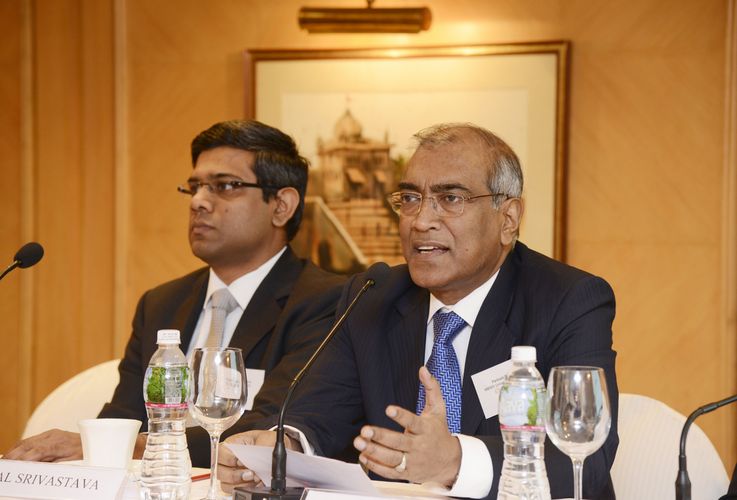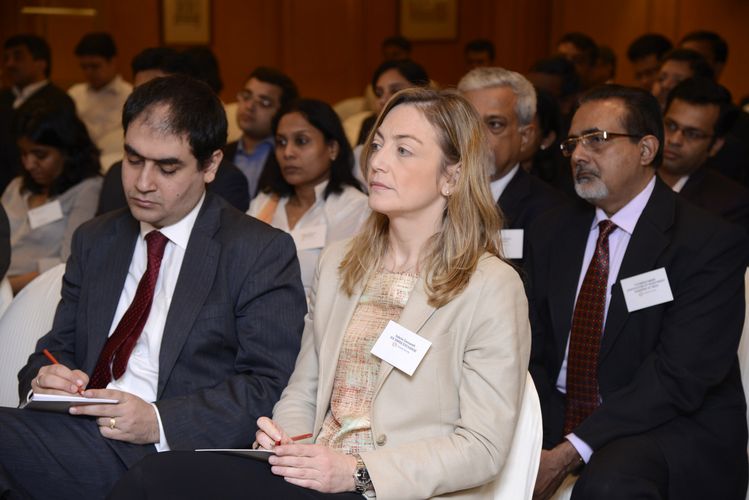To view the digital version of this report please click here.
To purchase printed copies or a PDF of this report, please email gloria.balbastro@thomsonreuters.com.
IFR: Today is actually an interesting day to have this roundtable because after a long time we have an Indian company, Power Grid trying to raise close to US$1bn from investors in India and abroad and for a change, we actually have a company which wants to raise money for its own growth and not the Indian Government trying to get money for its physical fiscal deficit.
The Indian economy continues to face macroeconomic and foreign exchange challenges. Does the economy as a whole need to go up before companies can start raising money abroad or are there individual growth stories which can raise money irrespective of what is happening to the economy. What are the challenges faced by Indian companies raising money abroad? What will be the impact of the forthcoming elections on the fund raising plans?
Samarth Jagnani, Morgan Stanley: From an Indian corporate capital raising perspective companies from all sectors raised capital between 2006 and 2008. The infrastructure and real estate sectors were at the forefront of raising capital and that was driven by good macroeconomic growth within the country and healthy demand for Indian paper. If you see in the last two years we have had companies which had unique business models out of India raise capital. Even from the government of India, companies with a very strong fundamental story are able to still raise capital such NTPC and Power Grid.
The question at this stage is whether companies in India actually want to raise capital to invest for growth or that there is enough unused capacity in their systems through which they can service the demand.
So that is primarily the reason why most people have not really raised capital per se if you compare India with rest of the world.
Globally, 2013 was one of the best years for equity capital markets and there is no reason why Indian companies cannot raise capital. The question is whether they want to raise capital. For companies whose stocks have been beaten down they may want to figure out debt restructuring solutions to tide over their short term payment. They might consider raising capital once the economy bounces back and their valuations become better. So per se I do believe that the environment still remains for companies to raise capital if they want to raise capital.
Marco Estermann: The domestic businesses of companies have to be doing well for them to achieve the valuations they want when they raise capital abroad.
Six Swiss Exchange is the European leader in the health-care, specialty chemicals and industrial sectors and companies that are in these sectors will be able to attract substantial demand.
Generally spoken, overseas investors don’t like if companies just step into the capital markets to raise funds and are never seen again. Investors want to invest in companies that have decent investor relations, who meet investors to explain their strategies and potentially raise additional capital in the future to further the growth of the company. Investors would appreciate companies coming back and meeting with them, talking to them and explaining their strategy going forward.
Avinash Gupta: We were told that our comments are now public so it cannot be too controversial but just to wake everybody up, is it a shortage of capital for Indian companies or is it a shortage of the right story, right type of companies or promoters trying to raise capital. To put things in perspective, approximately US$100bn has been invested by various private equity and other players through 5,532 deals since the Indian economy opened up in the early 1990s. Of this US$100bn, believe it or not, approximately only US$25bn has gone back into the companies for growth while US$75bn has been kind of badly spent. This has been the fault of not only the promoters but also of the managers, who managed that money.
Until recently investors said that the expectation of valuations was very high from Indian promoters.
Of late though the two main issues on which investors want more clarity are the Indian currency and corporate governance, more so the latter.
So do the macroeconomic conditions need to change more or do some things about corporate governance need to change before a lot more capital can come in. Indian companies also carry a lot of excess baggage which can be divested and the capital raised from it can be put into better use in the core business.
Bhavna Thakur: I am going to take off from where Avinash left and prove myself a bit of skeptic. If you see the amount of money that is coming into the Indian capital markets, the markets are still buoyant. The question that is often asked why despite these inflows there isn’t more primary capital raising.
Around US$18bn of capital came into India in 2013 and most of it came in the first half. We had US$2.5bn in September-October and in November we had about US$900m.
Around 65% of this money is Exchange Traded Fund money which is passive money. Most of this money is also going to support 10% of the benchmark index components and certain industries such as the information technology, pharmaceuticals and consumer industries and in some sense defensive stocks.
The secondary markets are buoyant because investors don’t want to be left out. Some of the foreign institutional investors who are invested heavily in India are not willing to decrease the exposure to India so what they are doing is swapping their exposure to safer stocks.
Power Grid’s US$1.6bn follow on offer has come at a very interesting time because it is a very stable stock, has given stable returns and is almost a yield stock. Demand for Power Grid is to have exposure to India infrastructure. Over the last one month we have had a number of Canadian pension funds looking at India infrastructure again from a growth perspective. But you know people are looking at way more safer investments. They are looking at governance. I think the reason why many companies inspite of needing capital have not come to the market is because promoters feel that they are not going to get the kind of valuations they got in 2007. I think the Indian markets whether it was through the private equity or through capital market investors got absurd valuations in 2007-2008 and if you are still holding on to those expectations you will not come to market.
We are expecting private equity which came in 2006-2007 to also exit either through an Indian listing or through an international listing. However, many of those who wanted to exit in 2013 will do so in 2014 or 2015 because of the year that has gone by. During the next six months I expect to see a number of prospectus filings with the regulator Securities and Exchange Board of India. Post the general elections in March there will be some more conversations around international listings.
I do think post election the markets will be a little more supportive given that political certainty is the large part of what people are looking at.
Pranjal Srivastava: India has traditionally always been a very strong bottoms up market. Investors have preferred certain stories at certain points and time. So, recently, we have seen a lot of action in the mid market space. Some of them have sold shares for compliance reasons but lot of them also been raising funds for expansion. In recent times, we have seen many sub US$100m deals in the institutional placement segment. We have seen that there are windows of opportunity for quality issues which are well priced. Obviously on the primary side there have been challenges but on the secondary side far more action is happening. The primary market is more dependent upon the macroeconomic and global factors and we have not seen a lot of prospectus filings with SEBI. We expect the market to open up once there is more clarity on the global side and on the macro side
The main point I think is that well priced quality transactions will see investor interest.
Paritosh Basu: Let me take the discussion to a different perspective. Half a decade back we got used to the idea that India will have an annual growth of 8%–9 % but subsequently we have come down to 4.5%–5% kind of a story. People are waiting for two things to happen – one is the general election and the next is the foreign exchange stabilization. It is good that the expectation is for either the United Progressive Alliance led by the Congress Party or the National Democratic Alliance led by the Bharatiya Janata Party to form the next government and not the Third Front. We are not worried about whether it will be the NDA or UPA, but we are have worried for the economic policies to be stabilized. I do not think any new government can do something radically different from what the current government has done. So my perspective is that whichever way the election results go, we have definitely seen the bottom of the economy and we are on the rising front. The current account deficit is being corrected and industrial production is coming up. Indian capital markets are going to see broad based activity and issuers are just waiting in the wings to file a lot of prospectuses with SEBI. I personally feel that political and economic issues are not going to create any difference.
I strongly believe that India has a big story to tell about Bharat and India. I am talking about the rural and urban economies to work in total co-ordination. So long India’s urban economy has been being served by the rural economy Bharat. But when the urban economy starts servicing the village economy, India will have a large potential for growth.
I am also bullish that the political system will be stable as India has learnt to manage coalitions.
Abhimanyu Bhattacharya: The last few months have been challenging for India. Few prospectuses have been filed with SEBI but having said that I think we are also seeing that a recovery of sorts is under way. The forthcoming general election is a big factor but I think that is something that is looking positive. The Finance Minister has also indicated that the liberalization of the financial sector and the capital markets is a top priority. The tremendous amount of rule making that is going on is a fallout of that initiative. The government has released the rules for overseas listing, the M S Sahoo panel is deliberating on the overhaul in the area of convertible bonds and depositary receipts while the K. M Chandrasekhar Committee recently submitted a report on the rationalization of the foreign investment route.
All this rule making will take the country to the next level in terms of capital market initiatives. We are seeing investor interest in sectors such as pharmaceuticals, information technology and consumer.
Tarun Gupta: When companies raise capital abroad what overseas investors are looking at is what is the driver for raising the money overseas rather than the domestic capital market. For example is it that a company is looking to list its European business separately. Investors also examine where the key management of that business resides and they would like to see a certain element of decision making at the European level.
Companies which are in certain sectors have no comparison or no peer group in India and have a very valid reason to look at an overseas listing. Also certain capital markets have a unique investor base. For example, if I talk about the Swiss capital market, you have got over 2,000 pension schemes which are by law mandated to invest a large portfolio of their assets in Swiss Franc denominated securities.
V. Jayasankar: The topic for discussion is very pertinent because a lot of issuers look at the options of listing in the overseas markets. But if you look at the listed space in the country today, the evidence tells us that a follow-on in India is probably faster and simpler as compared to doing a depositary receipt listing abroad because there is split of liquidity and may be there is no valuation arbitrage. Having said that there are few sectors like say internet, technology, e-commerce where the US is seen as a natural destination. For natural resources it is probably London and when it comes to business trusts people look at Singapore. Companies need to find out where their clients are located so that it is easier for investors to track them.
For example, ecommerce company MakeMyTrip went to US for a listing while Just Dial listed in India. Both the companies had very good listings but over a period of time the foreign exchange fluctuation did impact, the way MakeMyTrip really traded.
To continue reading this roundtable, click the relevant section. Introduction - Participants - Part 1 - Part 2 - Part 3


